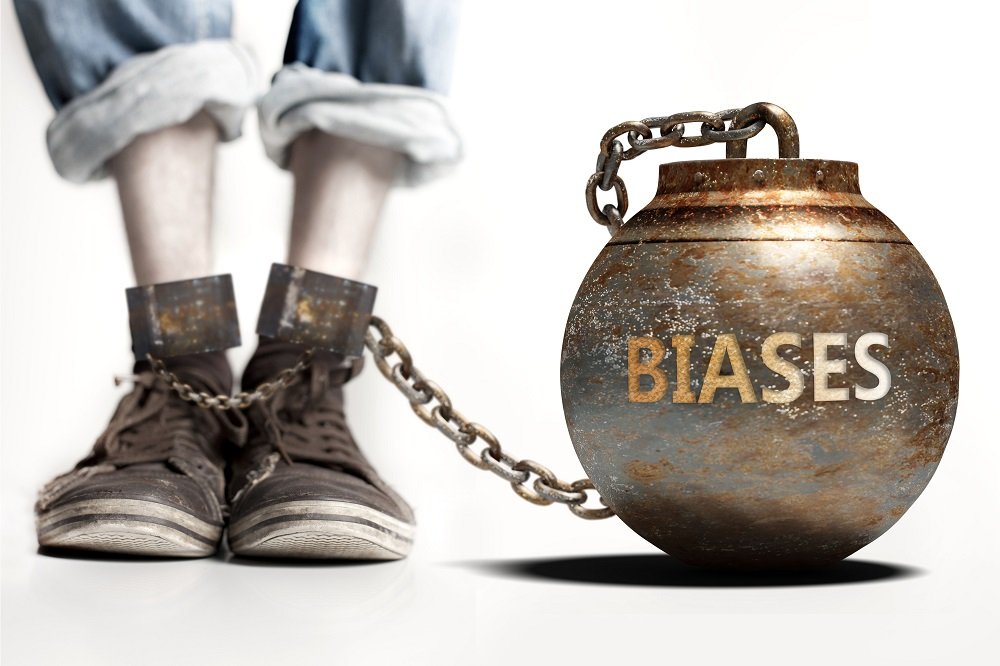The Danger of Investing Biases
When investing, we are bound by the limits of our own consciousness and subconscious. Psychologists have studied numerous biases that limit our worldview, and these extend into our investment decisions.
Knowing common biases that affect decisions about our finances is an important first step in conquering them. Additionally, understanding how others may be subject to their biases can help you understand seemingly irrational market activity… possibly creating an investment opportunity.
In this article, I have put together 10 of the most common investment biases.
These are not made up or sensationalized. These biases have been continually observed by researchers. They are ingrained into our very humanity. Thinking about how each of these biases have plays a role in our own lives, perhaps even outside of the Stock Market, can aid in identifying them in the future before they become a problem.

In this Article
What is an Investing Bias?
An investing bias is simply a cognitive or emotional bias that influences your investment decisions.
The world is an extremely complex place. Your brain attempts to simplify this vastness by taking shortcuts. These shortcuts can be considered adaptations that have developed over generations that may have served specific purposes.
Often, it appears that these biases have value in their ability to speed up the decision-making process. By ignoring some or most of the information presented to us, we may be able to key in on something that will allow us to take action to escape the grasp of a predator
When these shortcuts fail to deliver an appropriate result then it’s time to act. When it comes to investing, falling victim to your biases can leave you carrying the burden of negative consequences.
Confirmation Bias
Confirmation Bias is when a person looks for information that helps prove to them something they already believe. Information that disproves a desirable narrative is rejected.
This is much like wanting to read positive scouting reports about your favorite sports team. Given the choice between reading a positive or negative viewpoint on your team’s ability to recruit the best players, you will be more likely to choose the more favorable one.
This can be seen in investing when we seek out rationalizations about the market or individual stocks that supports our long or short theses. We want to believe we are right and so we actively shun the idea that we could be wrong by shutting out conflicting information.
Overconfidence Bias
Overconfidence bias is when we tend to think more highly of our abilities than is reality. We think we are stronger, smarter, and better looking than we are.
When it comes to investing, this results in a person believing they are better stock pickers than they ultimately are. We believe that we are closer towards our retirement goals than we are. We believe that common mishaps and investing mistakes don’t or won’t happen to us.
Loss Aversion
Loss aversion is a particularly nasty bias. In essence this bias states we would much rather not lose what we already have than earn the same amount. We are significantly more fearful of losing $1 than we are happy about earning $1.
This tilted emotional response leads us to buy high and sell low.
When the going gets tough in our investments we find ourselves being pushed to sell out of our position so that we can protect what we have left. This is all despite it being common knowledge that selling such positions during high market volatility is often unwise.
Familiarity Bias
The familiarity bias is when we tend to revolve our decision making around what we know. If you have historically invested in the banking sector, you will be more inclined to do so in the future. If you have leaned towards stocks and not bonds for a number of years, then this bias will likely continue into the future.
This bias towards the familiar makes us feel safe.
We feel there is less risk since we have previous experience. But this is not necessarily true. Our lack of comfort in investing in non-familiar assets leads us towards not diversifying as much as we should… or need… to reach our financial goals.
Oversimplification Tendency
As mentioned at the top of the article, our brains are not capable of comprehending the full complexities of reality. The ability to consider all factors that make up a system is just not possible. But the oversimplification tendency leads us to swing the pendulum hard in the opposite direction. We tend to simplify things too much.
By simplifying our understanding of our investments, we assign broad explanations for complex occurrences.
When the stock market falls at the same time the Federal Reserve has made some type of monetary move is great example. Every trading day is composed of a monumental number of investment decisions by individuals, institutions, and even computer programs. Our takeaway from a pricing move will be to simply assign it to what we can grasp… the Fed made a move and the market reacted.
But over the long term, we will be wrong about why major pricing moves occur. We will fail at understanding the nuances that occur in the backdrop and the result will be a loss in capital, an increase in risk exposure, or a loss of an opportunity.
Framing Bias
The framing bias suggests that the way data or information is presented can impact your decision making.
An example of this often can be seen when looking at advertisers and how they address certain ‘facts’ about a product. For example, a household disinfectant may choose to highlight it can kill 95% of all germs versus stating that it allows only 5% survival among germs. Both statements are saying exactly the same thing. However, your perception is completely different.
This type of framing bias can be found throughout the types of information sources one would typically use to make informed investing decisions. Below are just a few sources of information that likely imply at least some type of framing bias. The bias is not necessarily intentional on the part of the source.
- News sources. Particularly those with a strong editorial bent.
- Financial Advisors without Fiduciary Responsibility
- Annual and Quarterly Reports published by companies
- Political Statements
- Anything found on the internet (perhaps I’m biased on this?)
Mental Accounting
Mental Accounting occurs when an individual places different values on something despite them being equivalent. This usually leads to poor decision since the pretense is false.
For example, oftentimes investors have money in different accounts. Perhaps some one account has been designated by the investor to be a ‘play account,’ and the other a ‘serious account.’ The money in both accounts are real. The decisions made in both accounts constitute the full financial picture of the investor. Despite the designations between the two, the fact they are separated and treated differently will ultimately lead to a poorer outcome over the long run.
Mental accounting is the antithesis of fungibility. Fungibility is the ability of assets to be interchanged since they are essentially the same thing. If I give you a dollar bill and you give me 4 quarters then we have exchanged the exact same thing.
Mental Accounting would suggest that 4 quarters and 1 dollar bill have different intrinsic values and should be treated differently.
Hindsight Bias
In hindsight bias, a person believes they accurately predicted in outcome after it happens. If you put your money in a game of Roulette at the local Casino on red 3 times a row and win all 3 times you might be convinced that you knew it was going to happen for some reason… perhaps you had noticed a string of times it was hitting black just previously. Clearly this is false… there is no possible way you predicted the outcome.
In investing, hindsight bias can lead to overconfidence. You can begin to believe that moves you have made in your portfolio were accurately predicted based on something you did. You believe it wasn’t random. You believe it wasn’t caused by any factor that you didn’t account for.
Hindsight bias can lead to the justification of risky decisions. Although they worked the first time, they will likely not continue in the same manner as first experienced. Investment losses are sure to follow.
Groupthink / Herd Behavior
Herd behavior is phenomenon observed when a large group of people get together (physically or virtually) and tend to act in the same way. This occurs without individuals likely knowing the full reason of why they have made a decision.
Examples of this include riots, the movement of crowds, and even voting.
In investing, herd behavior manifests itself through things like asset bubbles and sharp selloffs. Looking back to the late 1990s, the dot-com bubble was largely inflated by large swarms of people allocating capital towards assets that were clearly and admittedly overpriced. The sentiment at the time was that everyone else was doing it so it was okay… history proved otherwise.
Being aware of the why of your decisions can help you see through this behavior. If you don’t understand why perhaps you have been influenced by the overall crowd to take a certain action without your actual consent.
Anchoring Bias
Anchoring bias occurs when the first piece of information on a topic becomes more important for no other reason than it was the first piece you came across.
Think of this bias as the First Impression Effect. We are told growing up that it is important to make a positive first impression. This advice is rooted in our own psychology. When we meet someone, this first interaction will have a greater weighting than subsequent interactions.
In investing, anchoring can occur when reading the news on a novel security, when we notice the first stock price we buy a stock at, or even on the initial interpretation of forward-looking guidance for a company. We can find ourselves attached to information that is irrelevant or information that has been superseded by better information.
What to do about Investing Biases
From my vantage point, my own biases and all, I see two ways to really combat these concepts. They are simple (perhaps I have oversimplified? You decide!). Both bullet points below are geared towards limiting the number of decisions you are a part of. You can’t make a biased decision if you don’t have to make a decision after-all.
- Hire a financial advisor to help you make your investment decisions. This additional viewpoint will help you see outside your own cognitive and emotional limitations.
- Invest in simple, broad-based strategies and do not deviate unless it is to rebalance your portfolio strategy. This could look like implementing the 60/40 Portfolio where you have 60% of your investments in the S&P 500 (or similar vehicle) and the other 40% in a bond fund or U.S. Treasuries with an eye towards rebalancing annually.
- Hire a financial advisor to help you make your investment decisions. This additional viewpoint will help you see outside your own cognitive and emotional limitations.
Acting now, in advance of these biases cropping up is the best way to beat them. You are human and will make mistakes, but if you are aware of your limitations and try to understand your own decision-making actively you will be successful… just don’t be too over-confident and don’t make a decision at all unless it is actually necessary.
I hope you enjoyed this article! If you have any other thoughts on this important subject or can think of any more relevant examples, then throw down in the comments for all to read!
Guy Money
As a formally trained Data Scientist I find excitement in writing about Personal Finance and how to view it through a lens filtered by data. I am excited about helping others build financial moats while at the same time helping to make the world a more livable and friendly place.



